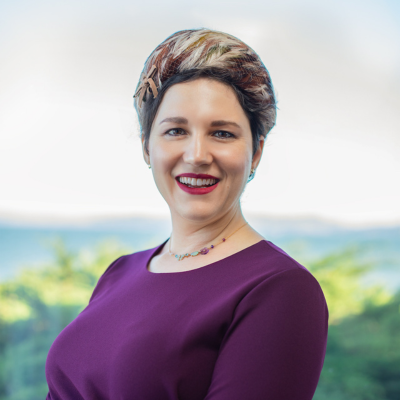Weighing in: Consumer perspectives on weight care
Acknowledgments: Thank you to the Evidation team for their collaboration on this work, with special gratitude to Ernesto Ramirez, PhD, Nell Marshall, DrPH, Abby Levine, PhD, and Jill Waldner.
Half of all Americans are projected to live with obesity by 2025 and new treatment options like GLP-1s are on the rise—it’s no surprise that weight care has been a hot innovation topic over the past few years. Many conversations about the future of weight care have centered on the perspectives of pharma players, providers, payers, and employers. We wanted to hear directly from consumers, who are forming their own opinions and perspectives on the current state of weight care, to round out a comprehensive view of the market.
We launched the 2024 Rock Health Weight Care Experience Survey Series (hereto referred to as the “Survey Series”), to better understand the weight care experiences and preferences of U.S. adults who are overweight or obese. Core questions we wanted to understand:
- What approaches are consumers using for weight loss?
- How are consumers interested in accessing weight loss treatments?
- What are consumers’ top barriers to receiving GLP-1 treatment?
- How are consumers thinking about combining multiple approaches to weight loss?
- What weight care support do consumers want most?
To answer these questions, we worked with Evidation1, a consumer app and direct-to-participant research platform connected to millions of individuals across the country, to run a series of three surveys with thousands of U.S. individuals over the course of eight months. We focused on respondents who had a history of being overweight and/or obese and had experience with weight management solutions. Weight loss can be a long-term process, and Evidation’s longitudinal survey capabilities enabled us to hear from individuals across multiple points in their care journeys, capturing information about their health behaviors and activities throughout.
Survey methodology
We deployed2 three surveys to Evidation members between October 2023 and May 2024. First, we sent Survey 1 to Evidation members (150,031 participated), and asked about weight history, weight-related goals, and experience with various weight loss methods. A few months later, we asked people from Survey 1’s response group to also complete Survey 2 if they had reported a prior diagnosis of overweight and/or obesity and if they had ever tried to lose weight (31,312 respondents participated within two weeks). Survey 2 questions focused on challenges and care preferences, with deep dives on GLP-1s and virtual coaching.
Evidation then assembled an analytical cohort of 10,000 people who took both Survey 1 and Survey 2 based on age, sex, and race/ethnicity3 to adjust for a more demographically representative sample.4 All respondents in this analytical cohort (n=10,000) reported prior diagnoses of overweight or obesity and experience with weight loss.
Finally, these same 10,000 people were asked to complete Survey 3 (7,800 respondents participated within 10 days), which focused on weight-related care settings, concurrent weight loss modality use, and oral prescription weight loss medications.
The data reported in this piece represent the responses of the 10,000-person analytical cohort (hereto referred to as “respondents”) for Surveys 1 and 2, and a subset of this cohort (7,800 people) for Survey 3.
What approaches are consumers using for weight loss?
In each survey, we asked respondents whether or not they were actively pursuing weight loss at the time of the survey. Sixty-two percent of respondents who completed all three surveys reported actively trying to lose weight at all three points in time, and 56% indicated they were moderately (36%) or very (20%) satisfied with currently available weight loss methods.
We also asked respondents whether or not their prior weight loss attempts had delivered the weight loss they wanted. Sixty-six percent of respondents reported losing less weight than they wanted to during their most recent weight loss attempt.5
Nearly all respondents used or were using exercise (88%) and diet (84%) to lose weight at the time of Survey 1. Three-quarters used or were using self-management tools like MyFitnessPal or Nutritionix. Twenty-two percent of respondents reported prior or current use of oral medications (e.g., Metformin, Contrave) and 11% reported prior or current use of injectable prescription medications (GLP-1s) for weight loss.
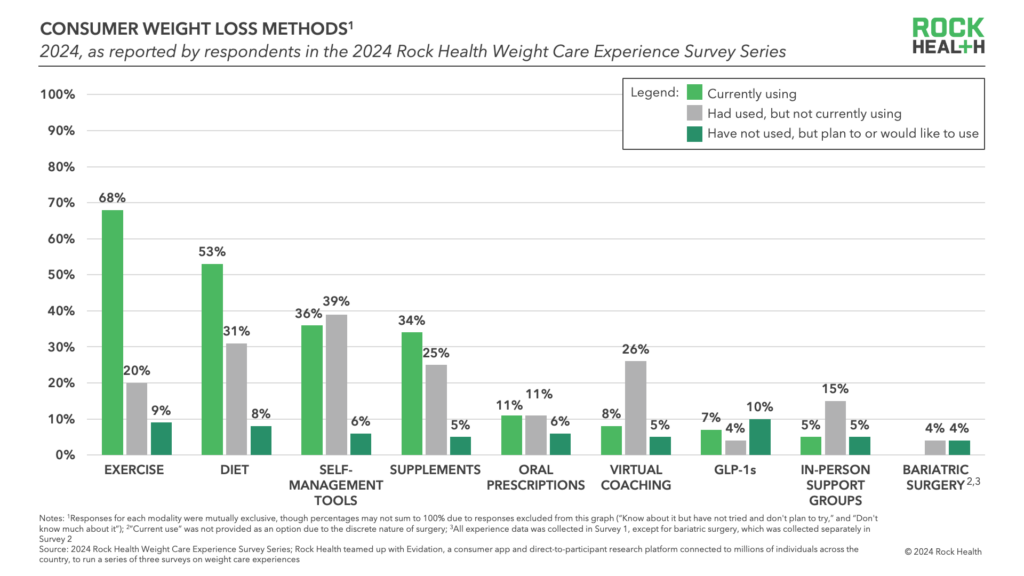
How are consumers interested in accessing weight loss treatments?
In Survey 2, we asked respondents about their openness to having weight care appointments in virtual versus in-person settings, and how these perspectives might be influenced by their familiarity with a clinician. The setting respondents were most open to for weight care was an in-person care setting with a clinician they knew; 58% of respondents were open to this option. Knowing the clinician makes a big difference within in-person settings—just 39% of respondents were open to in-person weight care with a new provider (a 19pp difference). A history of feeling unheard or discriminated against in medical settings can lead people in bigger bodies to delay care or feel uncomfortable with new providers, highlighting the importance of trust in these patient-provider relationships.
Beyond a greater degree of openness to in-person weight care with a known clinician, respondents did not report a pronounced difference between the other options (e.g., in-person care with a new provider, virtual care with a new or known provider). Forty-one percent of respondents were open to virtual care with a known provider, and 40% were open to virtual care with a new provider. The closeness of these two percentages suggests that established provider relationships might not be as important for people choosing virtual weight care.
Eighty-one percent of respondents who used or were using coaching services for weight loss did so through virtual or hybrid channels. Noom (31%), WW/WeightWatchers (22%), and Omada (11%) were the most popular choices among this group. Only a small percentage of respondents (15%) who had used or were using GLP-1s accessed them via virtual channels. Among respondents who had used or were using virtual GLP-1 care companies, WW/WeightWatchers (10%), Noom (7%), Alpha (5%), Found (5%), Calibrate (4%), and Teladoc (4%) were the top companies.
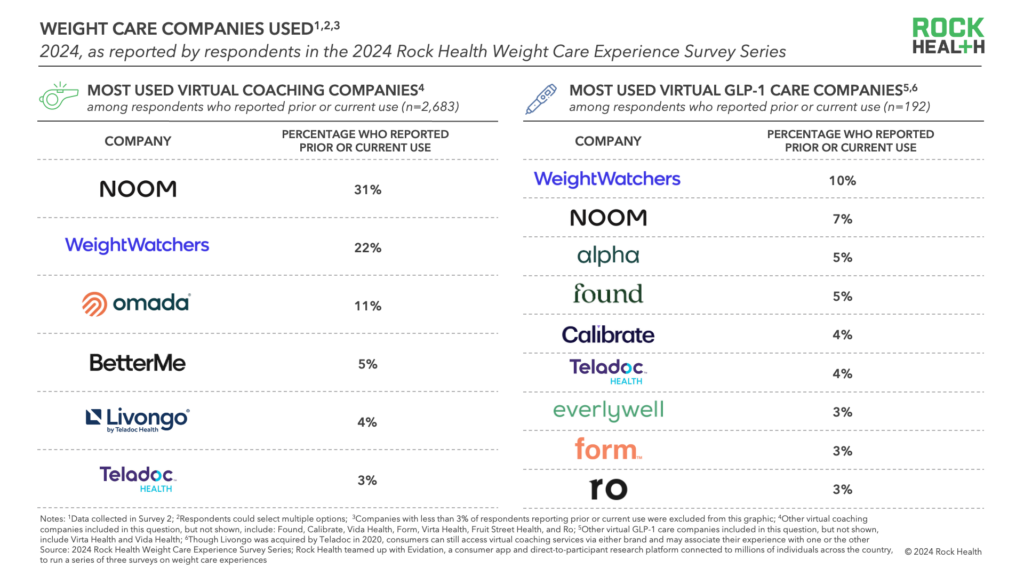
What are consumers’ top barriers to receiving GLP-1 treatment?
At the time of Survey 1, one in ten respondents were planning to or wanted to try GLP-1s—but many reported barriers to doing so. Nearly half (47%) of respondents hoping to start GLP-1s cited medication cost as the top deterrent. Even for those who had used GLP-1s in the past, drug prices often kept them from continuing: over one-third of respondents (36%) who had previously taken GLP-1s for weight loss indicated that cost was a key reason they stopped.
Insurance coverage further complicates access. Insurers have been hesitant to pay for weight-loss drugs like Wegovy and Zepbound, with some early movers recently dropping coverage. Among Survey 3 respondents who had previously taken or were taking GLP-1s, 41% had GLP-1 coverage denied by their health plans. Fourteen percent of respondents who had previously taken or were currently taking GLP-1s reported being required by their insurers to try another weight loss method before starting GLP-1s. Another 25% heard the same requirement from their clinicians.
How are consumers thinking about combining multiple approaches to weight loss?
Today’s clinical guidance for obesity treatment encourages patients to take multiple approaches to weight loss, like dieting and exercising concurrently. Many are following suit by doubling or tripling down on weight loss methods. Sixty-four percent of respondents reported trying two or more weight loss approaches simultaneously at the time of Survey 1. Of respondents combining multiple methods, the highest proportions reported using two (34%) or three (31%) methods at a time.
Among respondents who previously used or were using GLP-1s, diet (70%), exercise (60%), and stress management (36%) were the most common weight loss methods used alongside GLP-1s. However, not all individuals believed their multi-pronged approach was working. While 54% of respondents who used other methods alongside GLP-1s believed they had lost more weight as a result (a perspective supported by some early studies), 25% were unsure, and 20% didn’t think they had lost more weight as a result of combining other method(s) with GLP-1s.
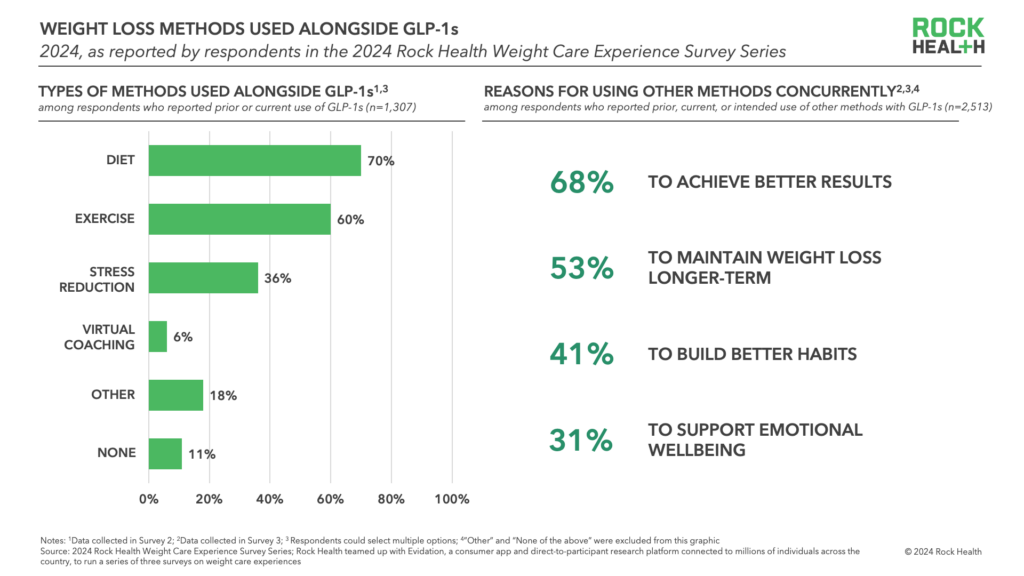
What weight care support do consumers want most?
Obesity is a chronic disease, and people need support to manage their weight or restart weight loss efforts. When we asked Survey 3 respondents about the type of weight loss support they desire, 33% cited exercise support, 29% nutrition support, and 15% mental health support. Among those who had used virtual coaching for weight loss, the top-valued features included activity tracking (31%), food tracking (31%), and weight tracking (23%).
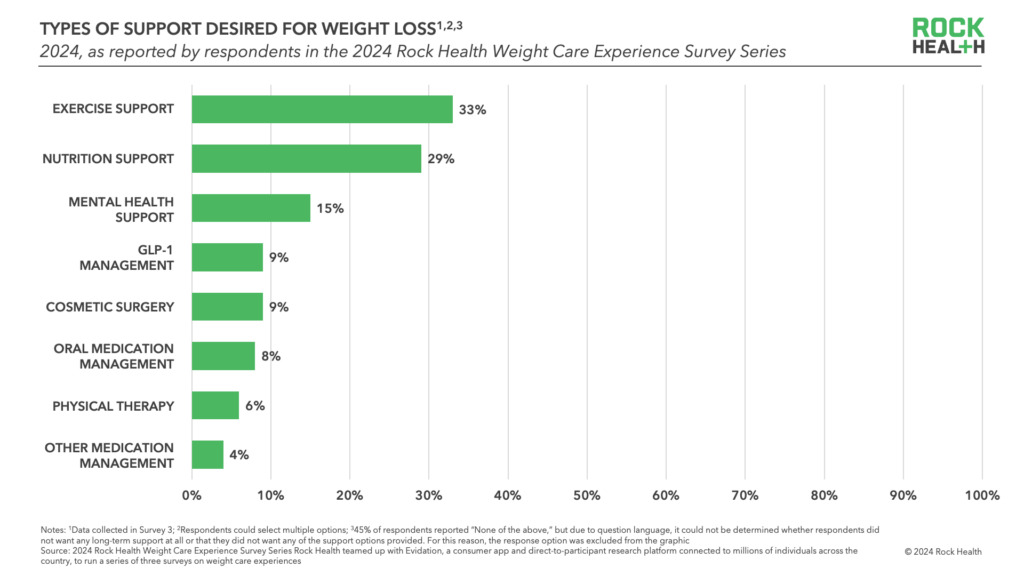
Many people using medications for weight loss expect to be on their treatments long-term. At the time of Survey 2, 48% of respondents using GLP-1s and 39% of respondents using oral medications for weight loss expected to use them long-term. In addition, a greater percentage of respondents taking medications for weight loss desired at least one type of support compared to respondents not taking medications. To us, this signals an important opportunity for industry players to complement anti-obesity medications with wraparound care programs and solutions.
Putting consumer weight care insights into action
Our Survey Series highlights the importance of tailored approaches that address individual lived experiences, preferences, needs, and barriers—and it’s clear that more research will be critical to evaluate and build the best programs. Weight care is not one-size-fits-all. Effective solutions must be adaptable to diverse preferences while promoting sustained engagement amongst consumers. We’re excited to work alongside the healthcare community to help center the consumer perspective and develop effective and personalized weight care strategies.
Want more detailed consumer insights to support your healthcare innovations?
Reach out to Rock Health Advisory to dig even deeper into consumer preferences and experiences with weight care. With guidance from our team, explore questions like:
- Where are consumers filling their prescriptions for GLP-1s or other weight loss drugs (e.g., at the pharmacy, by mail)? Do these trends vary by consumer demographics such as age or rurality?
- Which types of connected devices are consumers using to support their weight loss (e.g., wearables, connected scales, CGMs)?
- What health impacts are consumers reporting after they stop taking GLP-1s?
Interested in gathering unique consumer data about other changing areas of healthcare? Connect with us to learn more about how we can support your strategic goals with bespoke insights.
Tap into insights and strategic guidance for enterprise companies with Rock Health Advisory.
Get in touch with the venture team at Rock Health Capital.
Join us in building a more equitable future at RockHealth.org.
And last but not least, stay plugged into the Rock Health community and all things digital health with the Rock Weekly.
Footnotes
- Evidation is a Rock Health Capital portfolio company.
- Surveys were administered to Evidation’s community members via Evidation’s research platform, available via desktop and mobile app. Express permission was obtained from respondents to collect and share their survey responses.
- Respondents were matched by Evidation on age, sex, and race/ethnicity according to US Census data via iterative proportional fitting (IPF).
- In our Survey Series analytical cohort (n=10,000), 63% of respondents identified as female, 37% identified as male, and less than 1% identified as other.
Sixty-nine percent of respondents identified as white, 11% of respondents identified as Hispanic and/or Latino, 9% identified as Black or African American, 5% identified as Asian or Pacific Islander, 5% identified as multiple race/ethnicity categories, and less than 1% identified as American Indian or Alaskan Native, Middle Eastern or North African, Native Hawaiian or Other Pacific Islander, or other.
Forty-five percent of respondents reported a college degree, 25% reported graduate or professional education, 16% reported some college, no degree; 8% reported high school or GED, 5% reported trade or technical education, and 1% reported some high school or preferred not to answer.
Seventy-seven percent of respondents were urban-dwelling, 8% reported living in a suburban area, 7% in a large rural area, 6% in a small town or small rural area, and 1% did not provide geographical information.
Fourty-two percent of respondents were aged 35-54, 20% of respondents were aged 26-34, 18% were aged 55-64, 13% were aged 65+, and 7% were aged 18-25.
On average, respondents reported 1.1 (SD = 1.3) weight-related conditions, including conditions like hypertension, cardiovascular disease, and obstructive sleep apnea.
The survey cohort demographics referenced above correspond to the analytical cohort that completed Survey 1 and Survey 2. Sample demographics for Survey 3 (n=7,800) vary, due to survey attrition. - Respondents who were not “currently trying to lose weight” at the time of Survey 2 were asked about the relative amount of weight they lost at their last weight loss attempt. Respondents who indicated they “did not lose weight” OR “lost less than [they] wanted to and did not reach [their] target or goal” were considered to have “lost less weight than they wanted to.”


